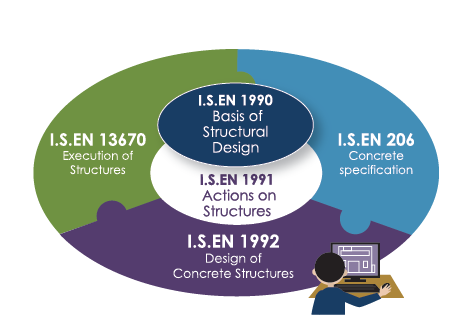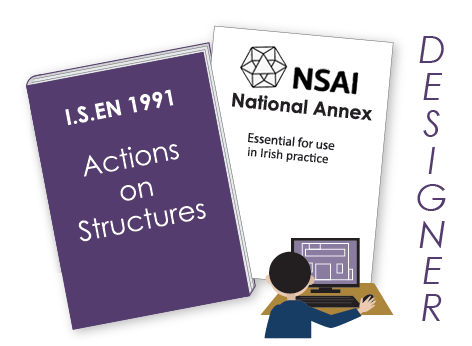2.2
I.S. EN 1991 Actions on structures (Eurocode 1)


Scope
I.S. EN 1991 provides comprehensive information on all actions that should normally be considered in the design of buildings and other civil engineering works.
Parts
I.S. EN 1991 has four main parts; the first part I.S. EN 1991-1 has seven sub parts (see below).
The other three parts deal with specialist aspects (e.g. traffic loads on bridges, actions by cranes, actions on silos and tanks)
I.S. EN 1991-1-1 Densities, self-weight and imposed loads
Provides guidance on:
- Permanent loads due to
- Densities of construction materials and stored materials
- Self-weight of construction works
- Variable loads due to Imposed loads for buildings
I.S. EN 1991-1-2 Actions on structures exposed to fire
Deals with thermal and mechanical actions on structures exposed to fire. It is to be used in conjunction with, other EN’s, for example, Fire Design parts of I.S EN 1992 Design of Concrete Structures. Part 1-2 gives general principles and application rules.
I.S. EN 1991-1-3 Snow loading
- Contains maps which give the characteristic values of the snow loads (standard load cases) on sea level for the relevant European countries.
- It also gives guidance on coefficients for exposure, thermal and roof shape.
- Snow load contour maps for Ireland are given in the Irish National Annex (as well as in TGD A of the Building Regulations)
I.S. EN 1991-1-4 Wind actions
Wind Loading enables the assessment of wind actions for the structural design of buildings and civil engineering structures up to a height of 200 m. The wind actions are given for the whole or parts of the structure, e.g. components, cladding units and their fixings.
- Wind speed map for Ireland is included in the Irish National Annex to this standard (as well as in TGD A of the Building Regulations)
I.S. EN 1991-1-5 Thermal actions
This part provides some guidance for evaluating the effects of thermal actions on buildings. Thermal actions must be considered to be variable and indirect actions.
I.S. EN 1991-1-6 Actions during execution
Describes principles and application rules for the determination of actions to be considered during execution of buildings and civil engineering works, including, among others, the following aspects:
- Actions on structural and non-structural members during handling.
- Actions due to prestressing effects
- Pre-deformations
- Temperature, shrinkage, hydration effects
- Wind actions
- Snow loads
- Actions caused by water
- Construction loads
- Accidental actions
I.S. EN 1991-1-7 Accidental actions
Covers accidental actions and gives rules and values for impact loads due to road, train and ship traffic and loads due to internal explosions.
Design for accidental load situations needs to be included mainly for structures for which a collapse may cause particularly large consequences in terms of injury to humans, damage to the environment or economic losses for the society.
Annex A is of special interest for buildings. Deemed to satisfy rules are presented in this annex in order to guarantee some minimum robustness against identified as well as unidentified causes of structural damage.
Three different safety categories are distinguished:
- Category 1: limited consequences
- Category 2: medium consequences
- Category 3: large consequences
For the above categories different methods of analysis and different levels of reliability are accepted.
(Building Consequence Classes are defined in Irish Building Regulations TGD A, Table 6; class 2 is sub-divided into lower and upper risk groups).
Note: Use the latest version of the standard, along with the accompanying National Annex, including any Addenda or Corrigenda updates for either, issued by NSAI. Irish Standards are available at www.NSAI.ie/standards.